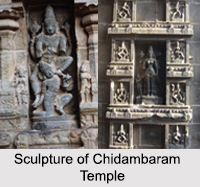 Sculpture of Chidambaram Temple gave birth to the sculpture and bronze image representation of Lord Shiva as the celestial dancer. It was commissioned by the Pallava king Swetavarman. One of the key features of this temple is that both "Shaivite" and "Vaishnavite" deities have been enshrined here. The presiding deities here are Lord Shiva Nataraja and Lord Govindaraja Perumal.
Sculpture of Chidambaram Temple gave birth to the sculpture and bronze image representation of Lord Shiva as the celestial dancer. It was commissioned by the Pallava king Swetavarman. One of the key features of this temple is that both "Shaivite" and "Vaishnavite" deities have been enshrined here. The presiding deities here are Lord Shiva Nataraja and Lord Govindaraja Perumal.
Chidambaram is a beautiful town in the Cuddalore district ruled from the beginning by Cholas, Vijayanagara`s, Maratha`s and the British rulers. It is believed that it was in Chidambaram that, Lord Shiva performed "Anandha Tandava" on the back of a demon and hence the name Nataraja.
Features of Sculpture of Chidambaram Temple
One of the major features of the sculpture of Chidambaram Temple is the bejewelled Nataraja idol. Chidambaram Temple in Tamil Nadu is one of the rare temples where Lord Shiva has been represented by an idol instead of a lingam. The well sculpted figure of the lord depicts him in a dancing pose, known as the cosmic dance. The oldest one amongst these is the Western "gopuram". Either side of the gateway towers has been adorned with sculpted figures.
One will come across the carved images of 108 Bharatnatyam dance poses and characters from Hindu mythology. It also shows goddess fighting the buffalo-demon and warlike "Skanda" astride his peacock. These figures have been used to embellish the first tiers. On the second tier of the "gopurams" Lord Shiva has been sculpted in several forms: "Bhikshatana", "Kankala", "Kalyanasundarar", "Somaskandar" and others. An interesting feature of the sculpture of Chidambaram temple "gopurams" is that the main figure of Lord Nataraja is missing. Usually a representation of the main deity is found on the towers of the South Indian temples.
There are nine well carved gateways in the Chidambaram temple. Four of these gateways have the "gopurams". One of the architectural features of the halls in Chidambaram temple is the well carved pillars. The finest examples of such pillars are found in the "Nritya Sabha". The "Nritya Sabha" or "Natya Sabha" is in the form of a chariot drawn by horses. According to legends this is the place where Lord Shiva and Goddess Kali have danced with each other. Raja Sabha is the thousand pillared hall that stands for the "Sahasraram" (a yogic chakra at the top of the head and a seta where the soul unites with God). This particular chakra is represented with the help of thousand petalled lotuses. The last one is the "Deva Sabha" where the "Pancha murtis" (five sculpted deities) are found. The five images are that of Lord Ganesha, Lord Somaskanda, His consort Sivananda Nayaki, Lord Muruga and Chandikeswarar, principle devotee of the lord. There are several sub shrines within the temple complex dedicated to several Hindu deities. These shrines have been adorned with sculptures around them.
Its bronze statues and stone sculptures depicts various deities and the famous "Thillai" trees of the surrounding forest. The sculptures of Chidambaram inspired the postures of classical dance of Bharatha Natyam. Two fishes facing each other were sculpted by the Pandyas. The East Gopuram has the idols of Pachaiappa Mudaliar and his wife Iyalammal. All "gopurams" have around fifty stone sculptures, each repeating some portions from the other.



















